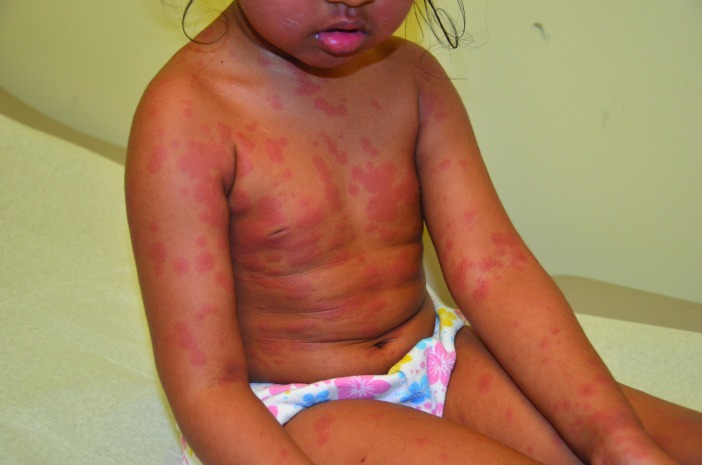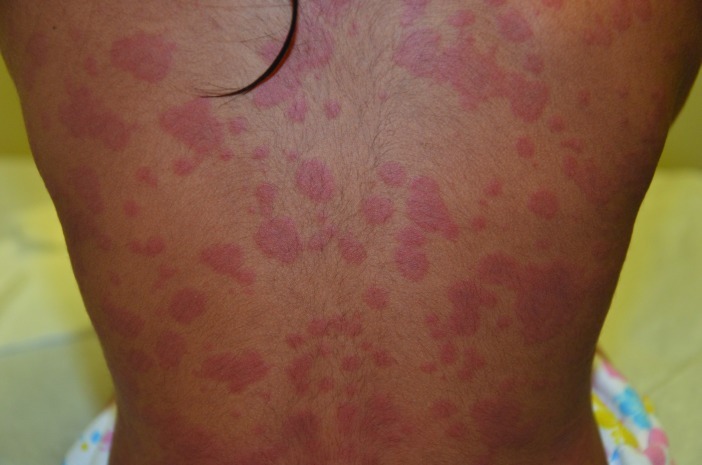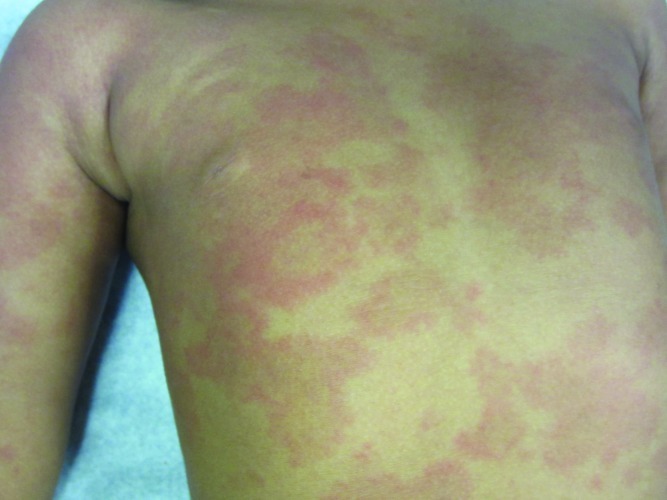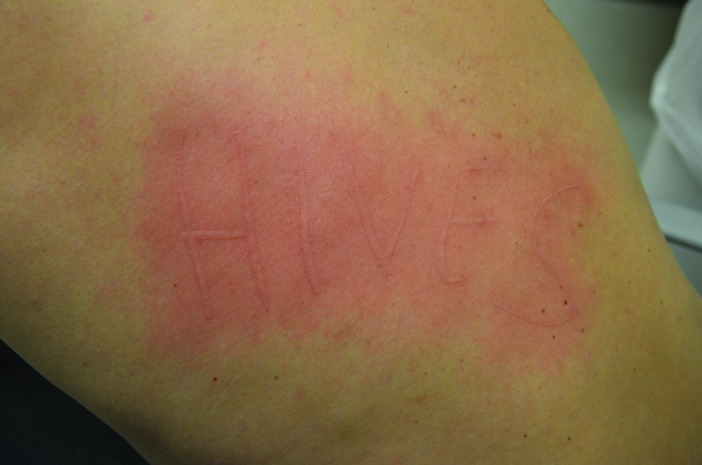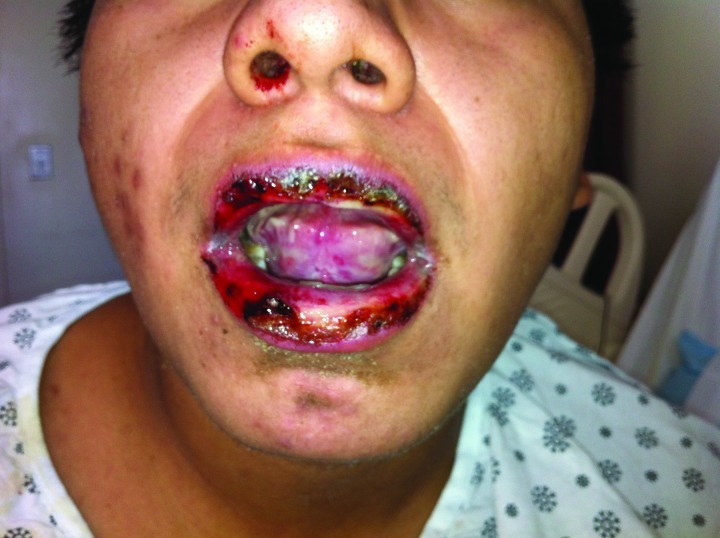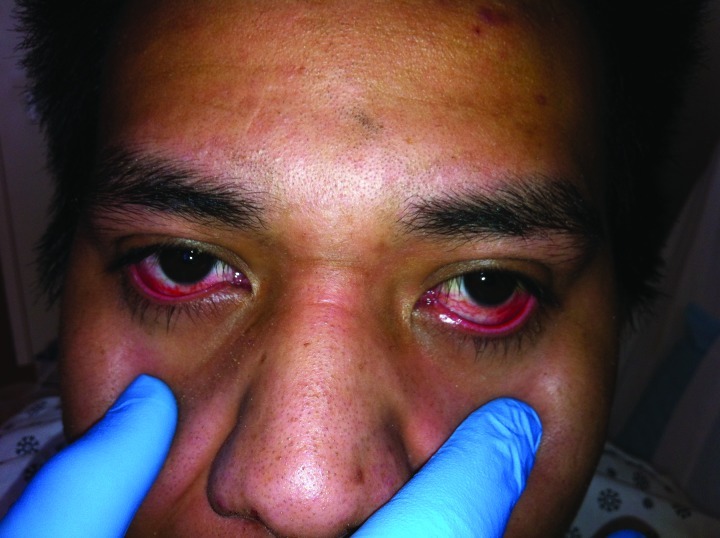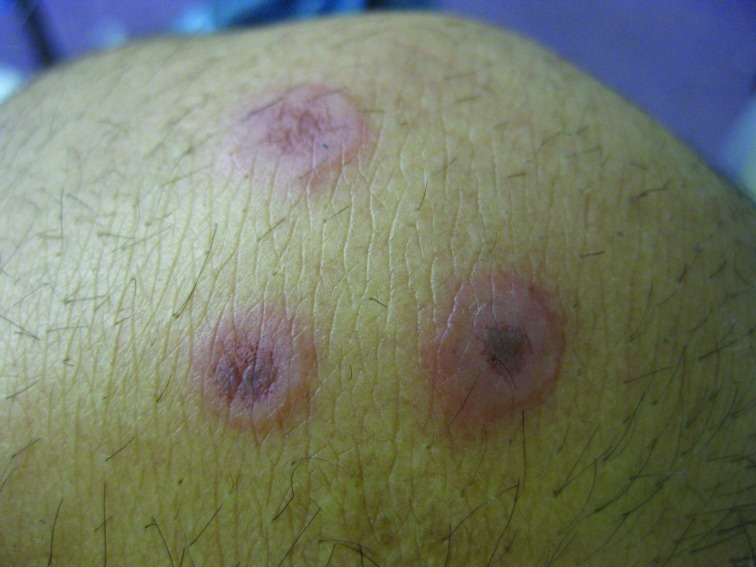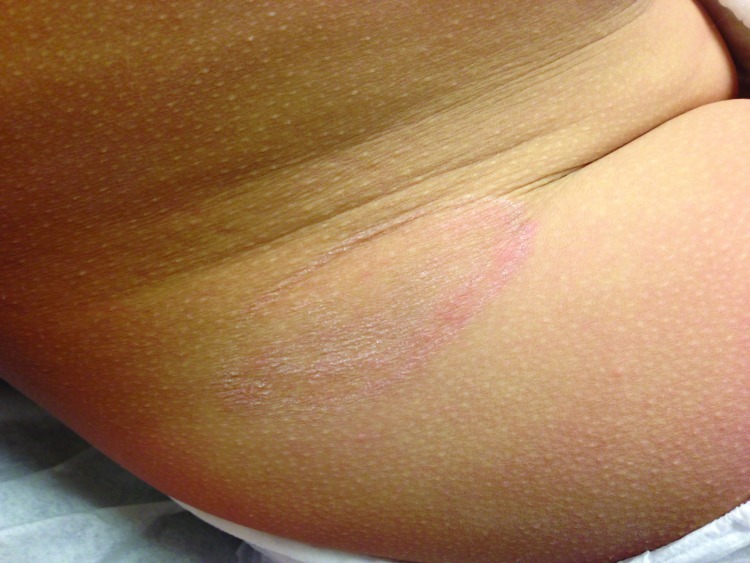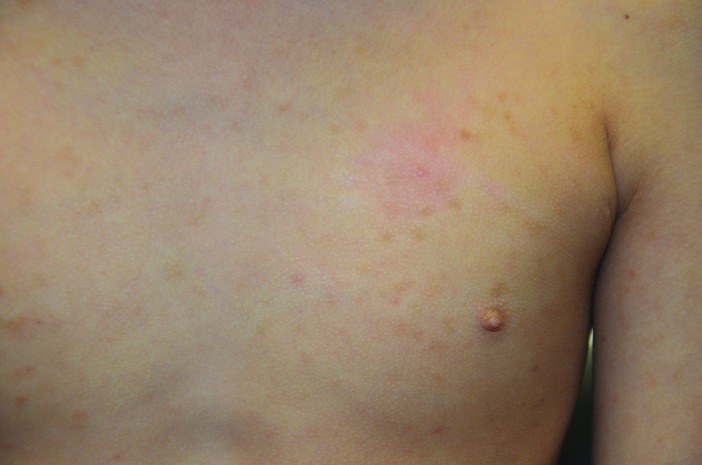Abstract
Urticaria multiforme is a benign cutaneous hypersensitivity reaction seen in pediatric patients that is characterized by the acute and transient onset of blanchable, annular, polycyclic, erythematous wheals with dusky, ecchymotic centers in association with acral edema. It is most commonly misdiagnosed as erythema multiforme, a serum-sickness-like reaction, or urticarial vasculitis. Since these three diagnoses represent distinct clinical entities with unique prognoses and management strategies, it is important that physicians distinguish urticaria multiforme from its clinical mimics in order to optimize patient care. By performing a thorough history and physical examination, the astute clinician can make the correct diagnosis and develop an appropriate, effective treatment plan while avoiding unnecessary biopsies and laboratory evaluations. The authors report a case of urticaria multiforme in a four-year-old girl in order to emphasize the distinctive morphological manifestations of this rare, albeit unique, disease seen in the pediatric population.
Urticaria multiforme, a morphological subtype of acute urticaria, is a benign cutaneous hyper-sensitivity reaction predominantly mediated by histamine that is characterized by the acute and transient onset of blanchable, arcuate, annular, polycyclic, erythematous wheals with dusky, ecchymotic centers.1,2 Also known as acute annular urticaria or acute urticarial hypersensitivity syndrome, urticaria multiforme is commonly misdiagnosed as erythema multiforme, a serum-sickness-like reaction, or urticarial vasculitis.2 Although these different clinical entities may present in a similar manner, it is important for the physician to look for specific clinical features that help distinguish them since each represents a unique diagnosis with different prognoses and management approaches.3 Herein, the authors report a case of urticaria multiforme occurring in a four-year-old girl in order to emphasize the distinctive morphological manifestations of this rare, albeit unique, disease seen in the pediatric population.
CASE REPORT
A four-year-old girl with no significant past medical history presented to the outpatient dermatology clinic with a one-week history of a pruritic rash. Starting on the trunk, the rash disseminated to include the extremities with involvement of the palms and soles. Three days prior to the onset of the rash, the girl’s mother reported a subjective fever, sore throat, and cough for which amoxicillin was prescribed by an outside primary care physician. Physical examination revealed generalized, blanchable, annular papules and plaques, some whealed and others targetoid with dusky centers, on the trunk, extremities, plams, and soles (Figures 1A and 1B). Palmar edema was also noted. The mucous membranes, genitals, and face were clear. The patient appeared to be in no acute distress. A review of systems was positive for fatigue, loss of appetitie, subjective fever, and cough. As per the patient’s mother, the child was up-to-date with all immunizations including varicella and measles, mumps, and rubella (MMR). A prelimiary diagnosis of erythema multiforme was given and symptomatic care with oral benadryl and topical desonide, as needed for itching, was provided. A serum complete blood count (CBC) with differential comprehensive metabolic panel (CMP) and erythrocyte sedimentation rate (ESR) as well as cytomegalovirus (CMV), Epstein-Barr virus (EBV), coxsackie, enterovirus, echovirus, herpes simplex virus (HSV) 1 and 2, and Antistreptolysin O (ASLO) were ordered. A biopsy was deferred as a suspected viral etiology was sought. The mother defered a chest x-ray and treatment for potential mycoplasma pneumonia infection. The patient was instructed to return to clinic in three days. At follow up, the rash had progressed to confluent, annular, polycyclic plaques with central clearing (Figures 2A and 2B). The patient’s cough had resolved and symptomatic care had significantly decreased the reported pruritus. Although serum EBV immunoglobulin M (IgM) was significantly elevated, IgG levels were normal. In light of these clinical findings with normal serum laboratory values and recent exposure to amoxicillin, a diagnosis of urticaria multiforme was given. The patient and her mother were reassured of the benign nature of this disease and asked to return to clinic in one week. At follow up, the patient was disease free and had returned to a normal state of good health.
Figure 1A.
Trunk and extremities of child on presentation. Annular papules and plaques with dusky centers
Figure 1B.
Up close of back lesions
Figure 2.
Trunk lesions three days after symptomatic treatment of oral benadryl and topical desonide
DISCUSSION
Clinical findings and differential diagnosis. The clinical presentation of lesions, age of onset, associated systemic symptoms, total eruption time, drug intake, and family history all need to be taken into account when working up a patient for suspected urticaria multiforme.4 Table 1 provides clinical features distinguishing urticaria multiforme from erythema multiforme, serum-sickness-like reaction, and urticarial vasculitis, three distinct clinical entities with different prognoses and management strategies.1,2,4,5 Urticaria multiforme represents an allergic hypersensitivity reaction that may be IgE dependent or independent.2 Manifesting in children usually four months to four years of age, urticaria multiforme is characterized by a transient cutaneous erythema and dermal edema.2 Typical lesions are initially characterized by small urticarial macules, papules, and plaques that rapidly expand to form polycyclic and annular blanchable wheals with ecchymotic, dusky centers.1,2 Affecting the trunk, extremities, and face, the evanescent lesions of urticaria multiforme are characteristic of any urticarial eruption that may last only minutes to hours, but in some instances persist beyound an acute time span.1,2 The course of disease is self-limited and usually resolves within 2 to 12 days, leaving normal skin after its resolution.2,4 Dermal edema can commonly involve the hands, feet, and face without associated laryngoedema.2,4 Dermatographism secondary to mast cell-mediated cutaneous dermal hypersensitivity at sites of skin trauma is a common part of the clinical picture in affected patients that can manifest in geometric or linear patterns.2 Pruritus is a universal complaint in patients with urticaria multiforme (Figure 3).4
TABLE 1.
Distinguishing features of urticarial multiforme, erythema multiforme, serum-sickness-like reaction, and urticarial vasculitis
| FEATURES | URTICARIA MULTIFORME | ERYTHEMA MULTIFORME | SERUM-SICKNESS-LIKE REACTION | URTICARIA VASCULITIS |
|---|---|---|---|---|
| Population affected | Infants and small children | All ages: 50% under 20 years | Adults | |
| Appearance of individual lesions | Annular and polycyclic wheals with dusky, ecchymotic centers Classic “target” lesion with purpuric or dusky, violaceous center that may blister. Middle ring of pallor and edema with an outer ring of erythema or blisters | Classic “target” lesion with purpuric or dusky, violaceous center that may blister. Middle ring of pallor and edema with an outer ring of erythema or blisters | Urticarial, polycyclic wheal with central clearing that may be ecchymotic-appearing | Hives with dusky, purpuric centers |
| Location | Trunk, extremities, face | Dorsum of the hands, palms and soles, forearms, feet, face, elbows and knees, penis (50%) and vulva2 | Face, trunk, extremities, and lateral borders of hands and feet | Trunk, extremities, face, lateral borders of hands and feet |
| Lesion duration | <24 hours | Days to weeks | Days to weeks | Days to weeks |
| Fixed lesions | No | Yes | Yes | Yes |
| Total rash duration | 2-12 days | 2-3 weeks | 1-6 weeks | 1-6 weeks |
| Mucous membrane involvement | Oral edema common, no erosions or blisters | Erosions with fibrin membranes, occasionally ulcerations, lips, oropharynx, nasal, conjunctival, vulvar and anal2 | Edema of the oral cavity is common with no erosions or blisters | Oral erosions with blistering of the lips, buccal mucosa, and tongue. May involve several sites, including the conjunctiva, nasal, and/or urogenital mucosa |
| Facial or acral edema | Common | Rare | Less common | Common |
| Dermatographism | Yes | No | No | No |
| Fever | Occasional low grade | Occasional low grade | High grade | Variable |
| Arthralgias | No | No | Yes | Yes |
| Common triggers | Viral illness, antibiotics, immunizations | Herpes simplex virus, other viral illness | Antibiotics | Infections, autoimmune processes, neoplastic processes, drugs |
| Associated symptoms | Pruritus | Mild pruritus or burning | Myalgias, arthralgias, lymphadenopathy | Variable |
| Laboratory findings | CBC, ESR, C-reactive protein, throat swab normal or negative IgE levels raised in 20% of cases | Elevations in ESR, WBC, and liver enzymes may be detected | Frequent elevations in ESR and C-reactive protein. Frequent neutropenia with development of reactive, plasmacytoid lymphocytosis. Mild thrombocytopenia as well as eosinophilia may be seen | Elevated ESR, hypocomplementemia (70%), microhematuria, proteinuria |
| Histology | Indistinct from other subtypes of acute urticaria: Dermal edema with a perivascular lymphocytic infiltrate with few intermingled eosinophils | Exocytosis as well as spongiosis are apparent in conjunction with varying degrees of epidermal necrosis. Necrotic keratinocytes are generally present at all epidermal levels with an edematous, papillary dermis with dilated capillaries | Features consistent with urticarial without evidence of vasculitis | Nuclear debris or fibrinoid alteration of the microvasculature with or without extravasation of erythrocytes |
| Treatment | Discontinue offending agents, such as any new or unnecessary medications and antibiotics. Systemic H1 and H2 antihistamines are effective. Systemic steroids should only be given in severe cases refractory to antihistamine therapy | Systemic glucocorticoids consisting of prednisone 50-80 mg/d in divided doses should be given and quickly tapered. To prevent development of recurrent EM, control of herpes simplex with oral valacyclovir or famciclovir may be considered | Discontinue offending agents, such as new medications and antibiotics as well as supportive care and H1 and H2 antihistamines. Systemic steroids may be considered in severe cases | First-line therapy consists of H1 and H2 blockers plus nonsteroidal anti-inflammatory agents |
Figure 3.
Dermatographism. Linear wheals after writing on the skin
On physical exam, patients are nontoxic appearing and systemic symptoms are most commonly limited to mild fever (38°-39°C) of only a few days duration. Although many patients report an antecedent upper respiratory infection, otitis media, or viral symptoms, such as fagitue, body aches, and/or rhinitis, a minority of patients have evidence of a concomitant illness, such as cough or diarrhea during the course of disease.2 Furthermore, certain medications, such as furazolidone and aspirin, recent immunizations, as well as concurrent or recent antibiotic usage, especially amoxicillin, cephalosporins, and macrolides, have been implicated in precipitating or exacerbating disease in patients with urticaria multiforme.2,4,5
Urticaria multiforme is commonly misdiagnosed as either erythema multiforme, a serum-sickness-like reaction, or urticarial vasculitis. Table 2 provides differential diagnoses to consider when evaluating a patient for possible urticaria multiforme.1,2,4 A detailed history and physical examination are invaluable parts of the medical workup to arrive at the correct diagnosis. Of note, the true target lesions seen in erythema multiforme are typically not seen in patients with urticaria multiforme. Although initial skin lesions may all appear similar, they will progress to a unique clinical entity relatively quickly. Skin necrosis and blistering as well as mucous membrane involvement, arthralgias, and/or arthritis are absent in urticaria multiforme (Figures 4A and 4B).1 Pruritus frequently accompanies urticaria multiforme, but not erythema multiforme and urticiaral vasculitis, where pain and burning are more commonly reported. While the lesions associated with erythema multiforme, serum-sickness-like reactions, or urticarial vasculitis are fixed and last days to weeks, the skin changes of urticaria multiforme are transient and last less than 24 hours, similar to acute urticaria or juvenile idiopathic arthritis (Still’s disease). While dermatographism commonly makes up part of the clinical picture in urticaria multiforme and urticaria, it is classically absent in patients with erythema multiforme or serum-sickness-like reactions. While lesions characteristic of urticarial vasculitis and erythema multiforme can manifest with dusky, purpuric centers, these skin lesions usually resolve with postinflammatory dyspigmentation, which is not seen in urticarial multiforme (Figure 5).4,5
TABLE 2.
Grading scale for contact sensitization response scale for contact sensitization response
| Erythema multiforme |
| Serum-sickness-like reaction.5 |
| Urticarial vasculitis |
| Acute urticaria |
| Erythema chronicum migrans |
| Erythema annulare centrifugum |
| Familial annular erythema |
| Annular erythema of infancy |
| Juvenile rheumatoid arthritis |
| Mastocytosis |
Figure 4A.
Erythema multiforme, mucous membrane involvement. Crusted erosions on lips
Figure 4B.
Erythema multiforme, mucous membrane involvement. Bilateral conjunctival injection
Figure 5.
Erythema multiforme, skin involvement. Plaques with typical dusky centers
Pediatric patients with urticaria multiforme also commonly present with angioedema of the face, hands, and feet, which are not characteristic features of erythema multiforme.2 While patients with a serum-sickness-like reaction can present with facial and/or acral edema, this condition can be distinguished by its prominent fevers, myalgias, arthralgias, and lymphadenopathy.1,6,7 A common pneumonic for serum-sickness-like reactions demonstrating the clinical characteristics is “LAUF,” which includes lymphadenopathy, arthritis, urticaria, and fever.
Other conditions can present with skin lesions resembling urticaria multiforme as well. Annular, arcuate, erythematous plaques with a leading scaly peripheral edge are seen in patients with erythema annulare centrifugum (Figure 6). However, these lesions are chronic and generally persist for months or years and are associated with a concomitant distant fungal infection.4 The “bull’s-eye” lesion characteristic of erythema chronicum migrans occurs following an arthropod bite in association with Lyme disease. However, this lesion slowly enlarges over weeks to months and may be followed by arthritis as well as abnormalities in the neurological, cardiac, and immunological systems.4 The lesion characteristic of familial annular erythema is inherited in an autosomal dominant fashion and consists of slowly enlarging infiltrated papules that form erythematous rings with residual hyperpigmentation lasting several days after the center of the lesion fades.4,8 The macular and evanescent rash associated with juvenile idoipathic arthritis (Still’s disease) is classically accompanied by spiking fevers and arthritis.4 Finally, lesions characteristic of urticaria pigmentosa are usually accompanied by a wheal overlying the lesion on a background of hyperpigmentation (Figure 7).4
Figure 6.
Erythema annulare centrifugum. Erythematous annular plaque with scaling at the advancing edge and central hypopigmentation
Figure 7.
Urticaria pigmentosa, Darier’s sign. Inflammation and wheal formation as a result of physical stimulation of a skin macule.
Laboratory and microscopic findings. The diagnosis of urticaria multiforme can be made on history and physical examination grounds, thus detailed laboratory testing and/or skin biopsy is not routinely required in affected patients.1 While an elevation in acute phase reactants (ESR and/or CRP) may be seen in some patients, a completely normal CBC, ESR, blood and lesional bacterial cultures, stool sample, ASLO, and throat swabs may be found positive in many cases. Although unnecessary in the medical workup for a patient with urticaria multiforme, skin biopsies reported in the literature are indistinct from other subtypes of acute urticaria, which demonstrate dermal edema with a perivascular lymphocytic infiltrate with few intermingled eosinophils.1,4 Serum-sickness-like reaction has been similarly described as demonstrating features consistent with urticaria without evidence of vasculitis. However, the histopathology of serum-sicknesslike reaction has been described as under-reported and possibly misunderstood after a MEDLINE search from 1951 through 2010 revealed that among more than 100 case reports of serum-sickness-like reaction, only three articles described its histopathology.9 The histopathological spectrum of urticarial vasculitis ranges from minimal vascular damage associated with swollen endothelial cells and a sparse infiltrate of neutrophils, eosinophils, and lymphocytes to severe leukocytoclastic vasculitis. Nuclear debris or fibrinoid alteration of the microvasculature with or without extravasation of erythrocytes are the minimal essential criteria for a histopathological diagnosis of urticarial vasculitis.10 Erythema multiforme is characterized by histopathology distinct from urticaria multiforme. Exocytosis as well as spongiosis are apparent in conjunction with varying degrees of epidermal necrosis. Necrotic keratinocytes are generally present at all epidermal levels with an edematous papillary dermis with dilated capillaries.11
TREATMENT
Treatment of urticaria multiforme is largely symptomatic since episodes are self-resolving within two weeks in the vast majority of cases, as was seen in our patient.12 Any medications suspected of precipitating disease should be discontinued. Most patients will require systemic therapy with an H1 antihistamine, such as cetirizine, diphenhydramine, or hydroxyzine with or without an H2 antihistamine, such as ranitidine, in order to achieve optimal symptomatic relief.2,5 Combination therapy of oral antihistamines has been shown to be effective in a majority of cases, with symptoms resolving in most patients within 24 to 48 hours.1 Treatment with systemic corticosteroids should be reserved for only the most severe cases refractory to combination antihistamine therapy. Topical therapy with antipruritic agents, such as topical corticosteroids, calamine, pramoxine, colloidal oatmeal, and/or menthol can be used. Exhaustive laboratory evaluations for an infectious etiology is not recommended since these tests rarely yield clinically important information.2
CONCLUSION
To avoid unnecessary biopsies and laboratory evaluations, physicians should be able to distinguish urticaria multiforme from its clinical mimics in order to optimize patient care. By performing a thorough history and physical examination, the astute clinician will make the correct diagnosis and develop an appropriate, effective treatment plan. Although a broad differential should be kept in mind when evaluating any rash in the pediatric population, the evanescent nature, urticarial lesions with acral angioedema, and dermatographism, in conjunction with an optimal response to systemic antihistamine therapy within 24 to 48 hours, clearly supports a diagnosis of urticaria multiforme.
Footnotes
DISCLOSURE: The authors report no relevant conflicts of interest.
REFERENCES
- 1.Starnes L, Patel T, Skinner RB. Urticaria multiforme—a case report. PediatrDermatol. 2011;28(4):436–438. doi: 10.1111/j.1525-1470.2011.01311.x. [DOI] [PubMed] [Google Scholar]
- 2.Shah KN, Honig PJ, Yan AC. “Urticaria multiforme”: a case series and review of acute annular urticarial hypersensitivity syndromes in children. Pediatrics. 2007;119(5):e1177–e1183. doi: 10.1542/peds.2006-1553. [DOI] [PubMed] [Google Scholar]
- 3.Ghosh S. What’s new in urticaria? Indian J Dermatol. 2009;54(3):280–282. doi: 10.4103/0019-5154.55642. [DOI] [PMC free article] [PubMed] [Google Scholar]
- 4.Tamayo-Sanchez L, Ruiz-Maldonado R, Laterza A. Acute annular urticaria in infants and children. Pediatr Dermatol. 1997;14(3):231–234. doi: 10.1111/j.1525-1470.1997.tb00246.x. [DOI] [PubMed] [Google Scholar]
- 5.Guerrier G, Daronat J, Deltour R. Unusual presentation of acute annular urticaria: a case report. Case Reports in Dermatological Medicine. doi: 10.1155/2011/604390. 2011; Article ID 604390. [DOI] [PMC free article] [PubMed] [Google Scholar]
- 6.Mortureux P, Leaute-Labreze C, Legrain-Lifermann V, et al. Acute urticaria in infancy and early childhood. Arch Dermatol. 1998;134(3):319–323. doi: 10.1001/archderm.134.3.319. [DOI] [PubMed] [Google Scholar]
- 7.Sackesen C, Sekerel BE, Orhan F, et al. The etiology of different forms of urticaria in childhood. Pediatr Dermatol. 2004;21(2):102–108. doi: 10.1111/j.0736-8046.2004.21202.x. [DOI] [PubMed] [Google Scholar]
- 8.Beare JM, Froggatt P, Jones JH, Neill DW. Familial annulare erythema. Br J Dermatol. 1966;78:59–68. doi: 10.1111/j.1365-2133.1966.tb12176.x. [DOI] [PubMed] [Google Scholar]
- 9.Tolpinrud WL, Bunick CG, King BA. Serum-sickness-like reaction: histopathology and case report. J Am Acad Dermatol. 2011;65(3):e83–e85. doi: 10.1016/j.jaad.2011.02.037. [DOI] [PubMed] [Google Scholar]
- 10.Barksdale SK, Barnhill RL. Vasculitis and related disorders. In: Barnhill RL, Crowson AN, Magro CM, et al., editors. Dermatopathology. 3rd ed. China: McGraw Hill Medical; 2010. pp. 202–204. [Google Scholar]
- 11.Ramos-Ceballos FI, Horn TD. Interface dermatitis. In: Barnhill RL, Crowson AN, Magro CM, et al., editors. Dermatopathology. 3rd ed. China: McGraw Hill Medical; 2010. pp. 342–344. [Google Scholar]
- 12.Myers SR, Lavelle J. Picture of the month—quiz case. Pneumonia with associated urticaria multiforme rash. Arch Pediatr Adolesc Med. 2009;163(12):1157. doi: 10.1001/archpediatrics.2009.221-a. [DOI] [PubMed] [Google Scholar]



